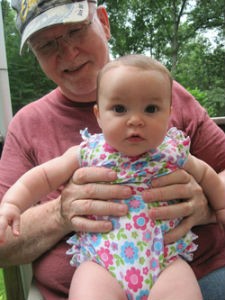
Imagine if you could no longer remember how to dress yourself or use the toilet.
Imagine if you could no longer control your behavior, lashing out aggressively and acting inappropriately.
Now, imagine if you’re the one experiencing this as it happens to someone you love.
Sadly, this is a reality for more than 5 million Americans who have Alzheimer’s disease, as well as those with other types of dementia. It’s also the reality for the families who care for them. Families like Tom and Gisèle Mix of Ada, Michigan, and their children.
Tom was enjoying his retirement and spending time with family when his wife, Gisèle, began to notice changes in him. Once an avid reader, Tom no longer read books and couldn’t seem to start or finish projects around the house. He seemed confused at times and was easily agitated.
Then one night when they sat down for dinner, Tom looked at Gisèle and said, “Who are you?” This startling moment was a turning point for the entire family. They knew something was terribly wrong with Tom.
Aging boomers drive pressing need for effective therapies
Every 67 seconds someone develops Alzheimer’s, the most common type of dementia, which is a general term for a decline in mental ability severe enough to interfere with daily life. Memory loss is just one example.
Alzheimer’s is not a normal part of aging, although increasing age is the greatest risk factor. It’s also progressive, getting worse over time. Treatment can help with symptoms, but can’t slow it down, stop or reverse it.
With the huge baby boomer generation now entering its senior years, experts anticipate a surge in Alzheimer’s cases.
A recent report by the Alzheimer’s Association projected 1 in 9 people older than age 65 and 1 in 3 older than age 85 will face Alzheimer’s in the years to come. The cost of treatment could swell to $1 trillion a year by 2050 in the U.S. alone.
Tom and Gisèle’s daughter-in-law Jessica describes what she witnessed in August 2011 when the family had to bring Tom to the emergency department.
“It was like his personality on steroids,” she said. “Same personality, yet more of it, and more intense.”
This was scary for the family. Tom was suspicious of people and thought Gisèle was an imposter. He was anxious, depressed, frustrated and angry.
Thinking he may have had a stroke, doctors first gave Tom medication to calm him for an MRI, “but that only made it worse,” Jessica said.
Funding, research partnerships a national priority
Today, there is an unprecedented effort under way to find better ways to diagnose and treat Alzheimer’s, delay its onset, and hopefully one day, prevent it from developing at all.
The National Institutes of Health, 10 biopharmaceutical companies, and several non-profit organizations have begun a five-year program, called the Accelerating Medicines Partnership, to help speed discovery of new therapies for Alzheimer’s disease, type 2 diabetes, rheumatoid arthritis and lupus.
Alzheimer’s disease is receiving the lion’s share of program funding: $129.5 million of the $230 million total.
The partners aim to gain a better understanding of how Alzheimer’s disease works, and then use that knowledge to identify biomarkers and find optimal targets for next-generation drug development.
Proteins, plaques, tangles and tau
“Researchers are primarily looking at two lines of investigation–amyloid beta protein plaques and tau protein tangles,” said Timothy Thoits, MD, a neurologist and neurocognitive disorders specialist with Spectrum Health Medical Group. “The brains of people affected by Alzheimer’s disease will show the presence of both.”
Plaque deposits, which build up between nerve cells and around degenerating nerve endings, are composed of amyloid beta protein.
Neurofibrillary tangles are found inside the nerve cells and are made of tau protein.
Another characteristic of Alzheimer’s disease is the reduced production of certain brain chemicals necessary for communication between nerve cells, especially acetylcholine, as well as norepinephrine, serotonin and somatostatin.
Researchers are faced with many questions. Which of these targets of investigation offers the most promise? Which patients will respond best to which lines of therapy? Are there other targets that may provide more alternative approaches?
But for patients and families dealing with the disease, there’s only one question: How quickly can these questions be answered?
For Gisèle and her family, an answer came in the form of a diagnosis for Tom: dementia with Lewy bodies, the second most common type of dementia after Alzheimer’s. It’s named for the abnormal protein deposits called Lewy bodies located in the regions of the brain involved in thinking, memory and movement.
Dr. Thoits, along with neuropsychologist Michael Lawrence, PhD, explained that Lewy body dementia often causes hallucinations and delusional thinking, which were likely responsible for Tom’s belief that people close to him were actually imposters. It also can cause rigid muscles, slowed movement and tremors, similar to Parkinson’s disease.
“Dr. Lawrence spent a full hour with my father-in-law,” Jessica said. “It was a huge gift. He knew how to talk to him without agitating him. And he did it with humor, putting all of us at ease.”
The family learned that people with this type of dementia can be very sensitive to certain drugs.
“That’s probably why what he received in the emergency department with that first episode actually made him more frantic,” Jessica said.
Reducing plaques in mice and men
One intriguing, but very early-stage, result that underscores the variety of approaches scientists are testing against Alzheimer’s was recently reported in Science Translational Medicine.
Researchers in Australia showed that ultrasound treatments helped remove amyloid plaques and improve memory in mice genetically engineered to develop symptoms of Alzheimer’s disease.
“While using ultrasound is a novel idea, and it certainly won’t come with the same side effects many drugs have, it’ll be a long, long time before we know what, if any, benefits it may have for humans,” Dr. Thoits said. “It can take a decade or longer for a treatment to go from research lab to patient use.”
Meanwhile, based on promising data from early investigations, a drug called aducanumab is headed to Phase 3 clinical trials later this year–the final step before applying for U.S. Food and Drug Administration approval.
This is the first time a drug has significantly reduced the hallmark build-up of amyloid brain plaques that often characterize Alzheimer’s and slow the progression of memory problems in patients with early signs of the disease.
However, the higher doses of the drug needed to produce these results also produced side effects. The most serious of these was brain swelling.
In the past, researchers have seen similar drugs developed which, despite showing early promise, failed in late-stage clinical trials. A key question for the next stage of testing will be if aducanumab can be given at a high enough dosage to slow the progression of Alzheimer’s, but still have an acceptable side effect profile.
Taking on tau
While amyloid protein plaques have been the focus of Alzheimer’s research and diagnosis for decades, a new Mayo Clinic study, published in Brain, shows tau protein may have a much stronger impact on mental decline over the lifetime of the disease.
Dr. Thoits agrees.
“Tau research may be the way to go,” he said. “Tau proteins transport nutrients within the brain’s neurons. With Alzheimer’s, tau is misshapen, turning into tangles and killing the neurons. Severity of tau does correlate with the depth and severity of dementia.”
This study was unique because researchers simultaneously looked at the impact of tau and amyloid, which allowed them to evaluate the progressive, wide-range impact of both proteins.
The study’s author emphasized that brain scanning to detect amyloid plaques for diagnostic purposes should not be ignored, but says there needs to be a shift to focus more on the impact of tau specifically for Alzheimer’s treatments.
“To develop effective therapies and better understand which will work best for each type of dementia, a targeted approach to Alzheimer’s research can’t be underestimated,” Dr. Thoits said.
Some of this research is taking place here in Grand Rapids. Both Van Andel Research Institute and Michigan State University have researchers looking at plaques and tau, he noted.
Caring for patients, families a local priority

When Tom thought that Gisèle was an imposter, she learned to leave the room and then return, declaring herself again, and he accepted that. When he insisted that his hospital room was home, or his personal business, family members went along with his direction.
“You learn not to argue,” Jessica said, “and you learn how to play along with the way that his mind works if it’s a matter of keeping him calm and safe.”
Tom eventually moved to an assisted living facility and then to Pine Rest for more intensive medication therapy. Unfortunately, his condition continued to deteriorate and he became more combative.
After a two-year journey, Tom contracted pneumonia. His family made the painful decision to move him to hospice care.
Looking back, Gisèle recalls the importance of the clinic’s support.
“The right people were operating as a team to address all the issues we were facing,” she said. “It’s such a difficult situation. Tom was in anguish because he couldn’t understand what was happening to him. We were in anguish watching him and trying to make decisions in his best interest. You can’t do it alone.”
Meeting the challenges of dementia in our community
A comprehensive, well-coordinated dementia program offers patients and families in West Michigan the support they need along this challenging journey.
Dr. Thoits and Dr. Lawrence formed the Spectrum Health program about five years ago, bringing multiple experts together to work with patients and their families through all aspects of the disease.
“Caregivers take the brunt of the load when a family member has dementia,” Dr. Lawrence said. “The patient is mostly not aware, but the family suffers. They need help.”
Because of the progressive nature of dementia, it’s imperative to get access to care and support as early as possible. Unfortunately, there’s a six-month wait for new patients to be seen at the clinic.
The doctors ask for help so they can help more people like Tom, Gisèle and their family.
 /a>
/a>
 /a>
/a>
 /a>
/a>
The information on dementia and Alzheimer Disease was very helpful, especially short video by Dr. Thoits.
May God bless each member of the dementia team for the care, concern and guidance given to each patient/family!
Thank you for your kind comments, Mary! We’re glad to be able to provide helpful information. Please check back frequently as we add more stories every day. 🙂